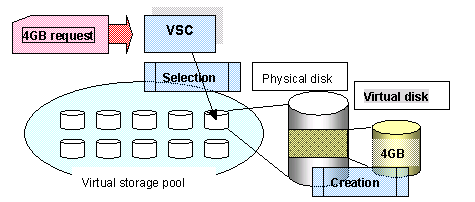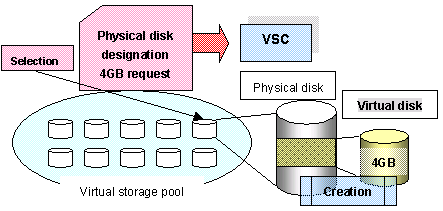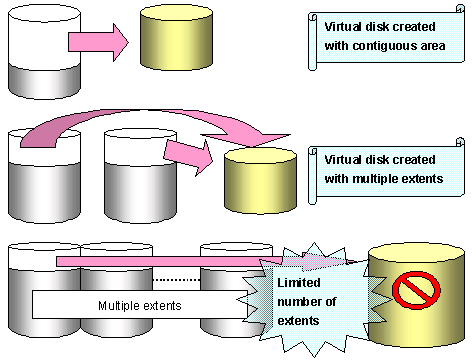The virtual disk is an independent logical volume containing physical attributes and information about physical disks. In other words, users can always create a disk with any desired capacity to be assigned to the transaction server without having to consider the capacity and device type of the physical disks.
You do not need any specific transaction for connecting a virtual disk to the transaction server. You can connect a physical disk and the transaction server using the same procedure as for connecting a virtual disk and the transaction server.
You can create a virtual disk from the physical disks registered in one virtual storage pool, which is the same as creating a physical disk (logical unit) from storage. However, you cannot create a virtual disk across multiple virtual storage pools.
There are two methods of creating a virtual disk: allowing VSC to automatically select the physical disk that constitutes a virtual disk or having the user manually select the physical disk.
Automatic selection of the physical disk
When you choose to allow VSC to automatically select the physical disk, specify the virtual storage pool name and virtual disk capacity. Then, VSC automatically selects the appropriate physical disk for the required capacity from the specified virtual storage pool to create a virtual disk.
Figure 2.6 VSC-Automatic selection of physical disks

Designation of the physical disk
When the user creates the physical disk, specify the virtual storage pool name, physical disk name, and virtual disk capacity.
Then, VSC checks whether the target physical disk exists in the specified virtual storage pool and whether there is sufficient space for the required capacity before creating a virtual disk. Since the user can only specify one physical disk, a virtual disk whose capacity exceeds that of the physical disk cannot be created.
Figure 2.7 Designation of the physical disk

Information
When assigning the physical area for the virtual disk from the physical disk, consider and create a physically contiguous area as one extension for the virtual disk. If VSC cannot assign a contiguous area for the requested capacity, divide the physical area into multiple extents to create a virtual disk.
You can delete any virtual disk that will no longer be used and save the physical space used by the virtual disk as free space for a new virtual disk.
VSC integrates and manages any unused space before or after the space to be freed as one extent.
Note
Note that there is a maximum limited number of extents that VSC can control for one virtual disk. If the physical area is fragmented by repeatedly creating and deleting virtual disks with various capacities during long-term system operation, creating a virtual disk with a required capacity may not be possible even when overall free space in the virtual storage pool is sufficient. In such case, register a new physical disk in the virtual storage pool in a way that the free space will not be fragmented.
Figure 2.8 Permissible extents of a virtual disk

Any error that occurs during virtual disk access is reported to the transaction server as a common I/O error. Thus, no special action is required for virtual disk access.
You can create a virtual disk across multiple physical disks and storages. However, since the reliability of such a virtual disk depends on that of said physical devices, we recommend that you use physical disks of the same device type or RAID group.
The encryption attribute of the virtual disk created with both encrypted and non-encrypted physical disks is non-encryption.
Similarly, the "disk type" for virtual disks that have been created using a mix of online and nearline disks will be "nearline".